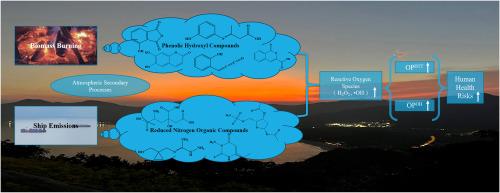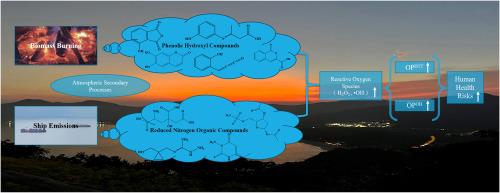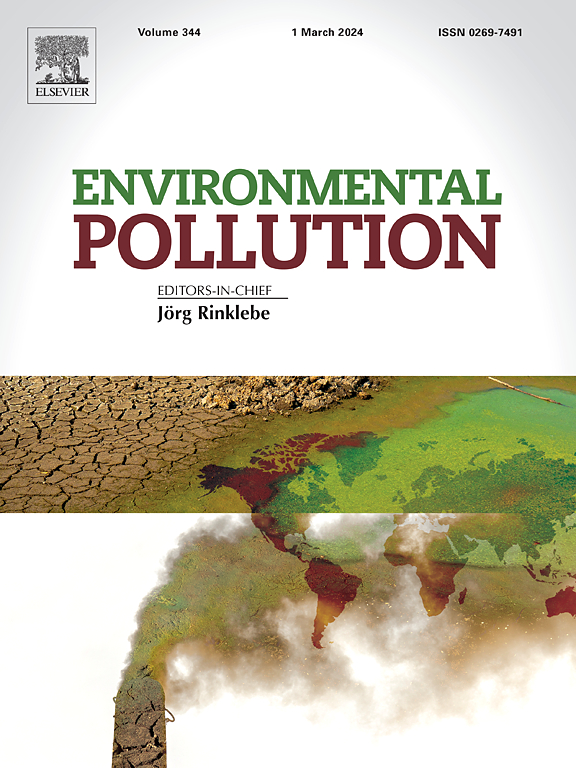环境 PM2.5 中主要氧化潜能活性物种的分子特征:生物质燃烧和船舶废气排放
IF 7.6
2区 环境科学与生态学
Q1 ENVIRONMENTAL SCIENCES
引用次数: 0
摘要
环境细颗粒物(PM2.5)可在体内催化产生活性氧,对人体健康造成危害。目前对主要氧化潜能(OP)活性物种的分子水平分析还很有限。在这项研究中,我们采用非靶向高分辨质谱法分析了冬季和夏季环境 PM2.5 样品中的水溶性有机成分。化学成分和回溯轨迹分析表明,生物质燃烧和船舶排放分别对冬季和夏季的 PM2.5 有显著影响。结合微阵列方法的显著性分析和相关性分析,确定了船舶和生物质燃烧排放的特征有机化合物中的 OP(OPDTT 和 OPOH)活性物种,并探讨了可能的机制。结果表明,船舶排放的特征化合物主要是有机胺类化合物,含硫成分较多;而生物质燃烧排放的特征化合物主要是CHO和CHON基团的含氧芳香族化合物。夏季 PM2.5 的高毒性可能来自船舶排放的还原有机氮化合物(C6H14N2O3S、C6H12N2O3S、C10H9N3O、C6H9N5O3S 和 C6H14N4O)。这些还原有机氮化合物可与金属形成络合物,影响其在气溶胶中的溶解度和反应性。酚羟基化合物是冬季生物质燃烧产生的 PM2.5 OP 的主要成因。酚类化合物氧化产生的半醌自由基可通过类似芬顿的反应进一步促进活性氧的生成。我们基于环境 PM2.5 样本的研究进一步加深了对船舶和生物质燃烧排放的有机化合物的分子水平及其与 OP 的关联的理解。本文章由计算机程序翻译,如有差异,请以英文原文为准。


Molecular characterization of major oxidative potential active species in ambient PM2.5: Emissions from biomass burning and ship exhaust
Ambient fine particulate matter (PM2.5) can catalyze the generation of reactive oxygen species in vivo, causing hazardous effects on human health. Molecular-level analysis of major oxidative potential (OP) active species is still limited. In this study, we used non-targeted high-resolution mass spectrometry to analyze the water-soluble organic components of ambient PM2.5 samples in winter and summer. Chemical components and back trajectory analysis revealed significant impacts of biomass burning and ship emissions on PM2.5 in winter and summer, respectively. Significance Analysis of the Microarray method and correlation analyses were combined to identify OP (OPDTT and OPOH) active species in characteristic organic compounds emitted from ship and biomass combustion emissions and to explore possible mechanisms. The results showed that the characteristic compounds emitted from ship were mainly organic amine compounds and contained more sulfur-containing components, while the characteristic compounds emitted from biomass burning were mainly oxygen-containing aromatic compounds of CHO and CHON groups. The high toxicity of summer PM2.5 might derive from reduced organic nitrogen compounds (C6H14N2O3S, C6H12N2O3S, C10H9N3O, C6H9N5O3S, and C6H14N4O) emission from ship sources. These reduced organic nitrogen compounds can form complexes with metals, affecting their solubility and reactivity in aerosols. Phenolic hydroxyl compounds were the main contributors to the PM2.5 OP from biomass burning in winter. Semiquinone radicals produced by oxidation of phenolic compounds can further promote the generation of reactive oxygen species through Fenton-like reactions. Our studies based on ambient PM2.5 samples further deepened the understanding of the molecular level of organic compounds emitted from ships and biomass burning, and their association with OP.
求助全文
通过发布文献求助,成功后即可免费获取论文全文。
去求助
来源期刊

Environmental Pollution
环境科学-环境科学
CiteScore
16.00
自引率
6.70%
发文量
2082
审稿时长
2.9 months
期刊介绍:
Environmental Pollution is an international peer-reviewed journal that publishes high-quality research papers and review articles covering all aspects of environmental pollution and its impacts on ecosystems and human health.
Subject areas include, but are not limited to:
• Sources and occurrences of pollutants that are clearly defined and measured in environmental compartments, food and food-related items, and human bodies;
• Interlinks between contaminant exposure and biological, ecological, and human health effects, including those of climate change;
• Contaminants of emerging concerns (including but not limited to antibiotic resistant microorganisms or genes, microplastics/nanoplastics, electronic wastes, light, and noise) and/or their biological, ecological, or human health effects;
• Laboratory and field studies on the remediation/mitigation of environmental pollution via new techniques and with clear links to biological, ecological, or human health effects;
• Modeling of pollution processes, patterns, or trends that is of clear environmental and/or human health interest;
• New techniques that measure and examine environmental occurrences, transport, behavior, and effects of pollutants within the environment or the laboratory, provided that they can be clearly used to address problems within regional or global environmental compartments.
 求助内容:
求助内容: 应助结果提醒方式:
应助结果提醒方式:


